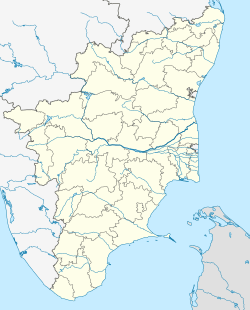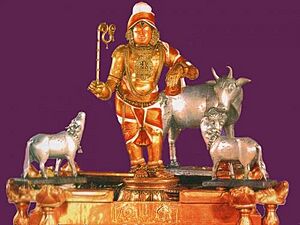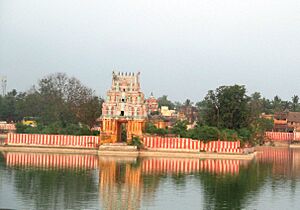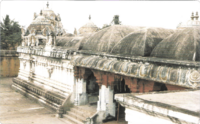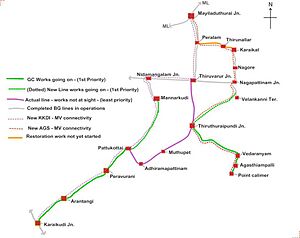Mannargudi facts for kids
Quick facts for kids
Mannargudi
Dakshina Dwarka, Rajamannargudi
|
|
|---|---|
|
Town
|
|
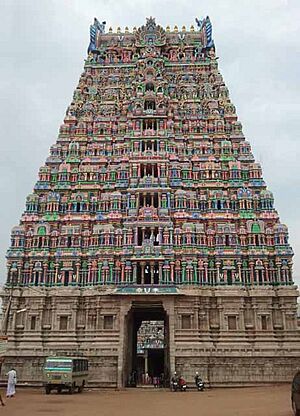
The temple tower of Sri Vidhya Rajagopalaswamy temple, the most prominent landmark in the town
|
|
| Nickname(s):
Mannai
|
|
| Country | |
| State | Tamil Nadu |
| District | Tiruvarur |
| Taluk | Mannargudi |
| Region | Chola Nadu |
| Government | |
| • Type | Selection Grade Municipality |
| • Body | Mannargudi Municipality |
| Area | |
| • Town | 11.55 km2 (4.46 sq mi) |
| Elevation | 45 m (148 ft) |
| Population
(2011)
|
|
| • Town | 66,999 |
| • Density | 5,800.8/km2 (15,024/sq mi) |
| • Metro | 105,336 |
| Languages | |
| • Official | Tamil |
| Time zone | UTC+5:30 (IST) |
| PIN |
614001
|
| Vehicle registration | TN 50 |
Mannargudi is a town in the Thiruvarur district of Tamil Nadu, India. It is the main town of the Mannargudi area. This town is about 28 kilometers (17 miles) from Thiruvarur, the district headquarters. It is also 310 kilometers (193 miles) from Chennai, the state capital.
Mannargudi is famous for its beautiful Rajagopalaswamy temple. This is a very important Vaishnavite shrine, dedicated to the god Vishnu. The town was first started as a special village by the Medieval Cholas around the 7th century A.D. Over time, many different rulers governed Mannargudi. These included the Vijayanagar Empire, the Thanjavur Nayaks, and the British Empire.
Today, Mannargudi is known for its farming, metalwork, and weaving industries. It is also a significant town in the delta region, after places like Thanjavur and Kumbakonam.
Contents
Understanding Mannargudi's Name
The name Mannargudi comes from two Tamil words. Mannar refers to the god Vishnu, and gudi means "place." So, Mannargudi means "Place of Vishnu."
People also called the town "Mannarkovil" or "Rajamannarkoil" because of the Rajagopalaswamy temple. Locals often shorten the name to "Mannai." Many Hindus call it "Dakshina Dwarka," which means "Southern Dwarka."
During the time of the Nayak dynasty, the Rajagopalaswamy temple had a very tall wall, about 25 feet (7.6 meters) high. This led to a famous saying: Mannargudi Mathil Azhagu, meaning "the walls of Mannargudi are beautiful." The town is also known as "Koil mattrum Madil Nagaram," which means "Temple and Wall City."
A Look at Mannargudi's History
Mannargudi began as a special village in the 7th century. The Medieval Chola king Rajadhiraja Chola (1018–1054 CE) helped develop it. He built the Jayam Kondanathar and Rajathirajeswara temples.
The famous Rajagopalaswami temple was likely built by Kulothunga Chola I (1070–1125 CE). Later Chola kings and the Thanjavur Nayak king Achyuta Deva Raya (1529–1542 CE) made the temple even bigger. The temple has old writings that tell us about gifts from Vijayanagara kings and later Nayak and Maratha rulers.
In 1311 CE, the Delhi Sultanate took control of Mannargudi. After some time under other rulers, it became part of the Vijayanagar Empire. When that empire declined, the Thanjavur Nayaks ruled Mannargudi. They considered the Rajagopalaswamy temple their main shrine. King Vijaya Raghava Nayak (1532–1575 CE) built the current temple structure, including the hall of a thousand pillars, the main gateway tower (gopuram), and the large wall around the temple. He was also called "Mannarudasan" because he did so much to improve the temple.
The Thanjavur Marathas took over in the late 1700s. Then, the British East India Company took control in 1799. Mannargudi became a municipality in 1866. During British rule, it became an important trading center. Rice, betel leaves, groundnuts, oil, and clothes were major goods traded here.
In 1944, old Chinese copper coins were found near Mannargudi. These coins date from 585 CE to 1275 CE, suggesting possible connections with Buddhism in the area. Mannargudi remained part of the Tanjore district until India became independent in 1947. It then became part of the new Tiruvarur district in 1991.
Geography and Climate of Mannargudi
Mannargudi is located at 10.67° N latitude and 79.43° E longitude. It is about 6 meters (20 feet) above sea level. The town sits on the banks of the Pamaniyar River, which is a branch of the Vettar River. This area has very fertile soil, which is great for growing rice. The land is mostly flat and is part of the rich Cauvery Delta.
Mannargudi is about 300 kilometers (186 miles) from Chennai, the state capital. It is 28 kilometers (17 miles) from Tiruvarur, the district headquarters. The closest airport is in Tiruchirappalli, about 90 kilometers (56 miles) away. The nearest seaport is Nagappattinam, which is 52 kilometers (32 miles) from Mannargudi.
From November to February, Mannargudi has warm days and cool nights. Summer starts in March and lasts until the end of June. Temperatures usually range from 37°C (99°F) in January to 22.5°C (72.5°F) in May and June.
Summer rains are not very common. The first monsoon, called the South-west monsoon, usually begins in June and continues until September. The Northeast monsoon starts in October and lasts until January. This monsoon brings more rain and is very helpful for the region's agriculture. The average rainfall is about 37 inches (940 mm). Common trees in the town include jack fruit, coconut, tamarind, and palmyra.
Mannargudi's Economy
Farming is the main job for people in Mannargudi. The town is also known for making cloth and metal products. Since it's an agricultural town, its economy mostly relies on farming income. Farmers grow crops like paddy (rice), cotton, sugarcane, and pulses like urad and mung bean.
Farming around Mannargudi depends on rivers like Koraiyaru, Mullaiyar, and Pamaniyar. Water from bore-wells also helps with irrigation. There are not many large factories in the town. However, there are some smaller ones, such as a sugarcane factory, a fertilizer factory, and a chemical factory.
Mannargudi has one of the largest coal reserves in India. About 19,500 million tonnes of lignite (a type of coal) have been found in the area. However, exploring these coal reserves has been difficult due to protests from local farmers.
Population and People
According to the 2011 census, Mannargudi had a population of 66,999 people. For every 1,000 males, there were 1,018 females, which is higher than the national average. About 6,174 children were under the age of six.
The average literacy rate (people who can read and write) in Mannargudi was 82.92%. This is higher than the national average of 72.99%. Most people in the town speak Tamil.
In terms of religion, the 2011 census showed that Mannargudi had:
Culture and Important Places
Mannargudi has three main Hindu temples: Jayamgondanatha temple, Rajathi Rajeswara temple, and Raja Gopalaswamy temple. The Pamani Naganathar Temple is also nearby.
The Rajagopalaswamy temple is the most famous landmark. Its biggest festival, Pangunith Thirivuzha, is celebrated in the Tamil month of Panguni (March–April). Other popular festivals include Theppothsavam (float festival) in Aani (June–July) and Adipooram (chariot festival) in Aadi (July-Aug). These festivals bring many visitors from nearby areas.
The Nayak kings in the 15th century encouraged music in the temples. Many musical instruments were used during temple services. Haridra Nadhi, the large temple tank of the Venugopalaswamy temple, is one of the biggest in the state. People take a holy dip in this tank during festivals.
Mannargudi also has four mosques for its Muslim community.
The Mannargudi Mallinatha Swamy Jain Temple is another important religious site. It is a Jain temple dedicated to Mallinathar, the 19th Tirthankara of Jainism. This ancient temple was built during the Chola dynasty in the twelfth century.
For nature lovers, the Vaduvoor Bird Sanctuary is about 12 kilometers (7.5 miles) away. The Muthupet Lagoon, a mangrove forest, is another beautiful spot located 29 kilometers (18 miles) from town.
Education in Mannargudi
Mannargudi has many schools and colleges. There are 17 schools and three arts colleges. The Findlay Higher Secondary School, started by the Wesleyan Mission in 1845, is the oldest school in town. It became a high school and college in 1883.
The town also has two engineering colleges and two polytechnic colleges. The Mannai Rajagopalaswami Government Arts College, founded in 1971, and the Sengamala Thayar Educational Trust Women's College are the main colleges here.
Town Services
The Tamil Nadu Electricity Board (TNEB) provides electricity to Mannargudi. The town gets its water supply from groundwater, managed by the Mannargudi municipality. In 2010–2011, about 3.53 million liters of water were supplied daily to homes.
Around 24 metric tonnes of waste are collected from Mannargudi every day. The municipality handles waste collection and disposal. There is a limited underground drainage system, so most wastewater goes into septic tanks or open drains. The municipality also maintains roads and drains.
Mannargudi has three hospitals, two maternity centers, and eight private clinics. There are over 2,600 street lamps to light up the town. The municipality also runs four markets, including vegetable markets and a farmer's market, to serve the town and nearby villages.
Getting Around Mannargudi
Several state highways connect Mannargudi to other towns. These include SH-63 (connecting to Thanjavur), SH-66 (connecting to Kumbakonam), and SH-202 (connecting to Tiruvarur).
The town has two bus stands. The main bus stand has 19 bus bays and a ticket reservation counter. The Tamil Nadu State Transport Corporation runs daily bus services to many cities from Mannargudi. You can find buses to Chennai, Tiruchirapalli, Coimbatore, Madurai, and other major towns. A new Ring Road, about 22 kilometers (14 miles) long, is being built to help reduce traffic.
The Mannargudi railway station connects to the Nidamangalam rail line. This line is about 18 kilometers (11 miles) long. The railway line was upgraded in 2011, and now there are express trains to Chennai and Coimbatore. There are also daily passenger trains to Thanjavur and Mayiladuthurai. An express train to Tirupati runs three times a week, and a weekly express train to Rajasthan also operates from Mannargudi. A railway link from Mannargudi to Pattukkottai is currently being built.
The closest seaport is Nagapattinam Port, which is 52 kilometers (32 miles) away. The nearest airport is the Tiruchirappalli International Airport, located 97 kilometers (60 miles) from the town.
See also
 In Spanish: Mannargudi para niños
In Spanish: Mannargudi para niños


